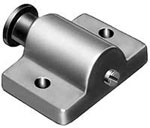
Spring stops offer a simple and effective workholding solution. Also known as stop buttons, they consist of a spring plunger in a mountable body. Once installed, the spring will apply pressure to the workpiece, thereby holding it in place. Here are six facts about spring stops you need to know.
#1) Aluminum Body
Most spring stops feature an aluminum body. The body is the frame that encapsulates the spring-loaded plunger. With an aluminum body, spring stops are lightweight and highly resistant to corrosion. They don’t rust like iron and iron alloys. Rather, aluminum body spring stops can withstand moisture.
#2) Available in Different End Types
When choosing a spring stop, you should consider the end type. Not all spring stops have the same end type. Some of them have a round end, whereas others have a square end. The end refers to the plunger at the end of the spring. It will press against the workpiece to prevent unwanted movement.
#3) Fixed vs Adjustable
There are fixed spring stops, and there are adjustable spring stops. Fixed spring stops are designed to apply constant pressure. Adjustable spring stops, on the other hand, support different pressure levels. With an adjustable spring stop, you can increase or decrease the amount of pressure it applies to the workpiece.
#4) Lowers the Risk of Damage
When compared to other workholding solutions, spring stops offer a lower risk of damage to the parts with which they are used. The spring-loaded design prevents workpieces from being clamped too tightly. Other types of workholding solutions use alternative mechanisms to hold workpieces in place, which can result in excess pressure that causes damage.
#5) Highly Flexible
In addition to protecting workpieces from damage, spring stops are highly flexible. They can adapt to the workpieces with which they are used. You can move a spring stop to better hold a workpiece. If it’s an adjustable spring stop, you can also increase or decrease the pressure level. Regardless, spring stops are highly flexible workholding solutions.
#6) Allows for Heat Expansion
Spring stops allow for heat expansion. Workpieces can expand as they heat up. With other workholding solutions, heat expansion such as this can result in damage. As the workpiece heats up and expands, it may crack or otherwise damage when held in place. Spring stops, however, allow for heat expansion while continuing to hold workpieces in place.
For light-duty workholding applications, you can’t go wrong with a spring stop. They will apply consistent and even pressure while holding workpieces in place.
